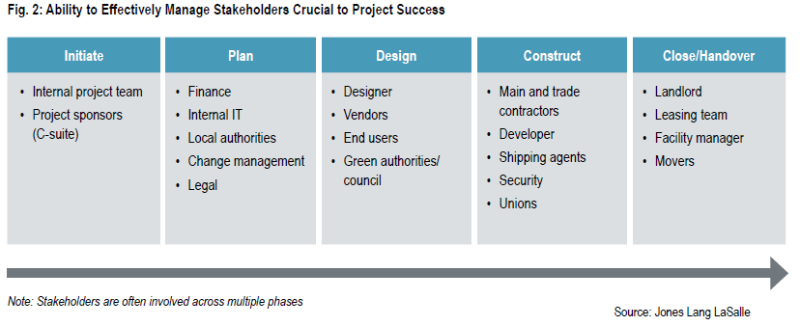You can often trace out-of-control construction project costs back to one thing: an inability to finish on time.
If you want to stay on budget, you must stay on schedule. But with so many moving parts and inevitable surprises along the way, how is this even possible?

There are a few tricks that effective managers can use to avoid crippling delays. We cover them below.
Whether you're a contractor working on an important project, a major developer, or a real estate investor, we've found six ways to help you understand how the best contractors in the business keep projects on track and maximize profits while doing so.
1. Minimize construction delays and blockers

There are two types of problems that prevent projects from finishing on time: delays and blockers. Expert project managers know how to identify and address each type.
A construction delay happens when things don't go according to plan, and since construction is often sequential, that's often unavoidable.
For example, you were planning to pour concrete in a specific two-day window, but it ends up raining. Now the project must be pushed back two days and contractors must reschedule.
Delays can also happen when a subcontractor doesn't show up on time, when work takes longer than expected, or when material shipments are delayed.
Blockers are different from delays in that a blocker is a task whose completion is necessary before other tasks can be undertaken. For example, you may have scheduled a mason to lay the bricks for your building, but you can't lay bricks unless the foundation has been poured.
Careful planning is a must if you want to avoid delays, and you must identify blockers well in advance of the project to keep them from being an obstacle.
2. Improve your management methods

Incompetent management is another major reason for project failure. Managers are responsible for creating a project plan that includes all the required elements and delivering the completed project by the deadline.
A construction manager is there to assign roles and responsibilities within a project and to coordinate labor and materials to the job site so work can get done in a timely fashion. A great construction manager can juggle several aspects of a detailed project plan while working to minimize delays and aggressively remove blockers that can hold up progress.
A white paper published by the Modular Building Institute highlights the need for more effective construction management:
“Time, money, and resources are wasted when projects are poorly managed, causing workers to have to wait around for tools and work crews' schedules to conflict; when work crews are not on–site at the appropriate time; or when supplies and equipment are stored haphazardly, requiring that they be moved multiple times." (Modular, 2010)
So how can you improve your own management effectiveness? There's actually a few tactics and techniques you can choose from that we covered in a recent article on construction project management methodologies.
3. Plan, plan, plan

When it comes to keeping your project on time, nothing is more important than having a detailed project plan to work from. A great project plan that can easily be updated as the project moves forward offers a bird's eye view of the project, enabling managers to quickly diagnose potential challenges and solve problems before they become costly delays.
Many contractors start projects of various sizes without a clear timeline, finalized drawings, or prior communication with critical subcontractors. That's a big mistake. Your project plan should be exhaustive—it should include every detail required to complete the project, while accounting for variables in the execution process that could create delays.
A successful plan also contains contingencies for unforeseen circumstances, creating clear guidelines for how your firm should respond to delays. You can use software services like eSUB or a number of other popular construction project management software options to streamline your project planning.

A sample project plan for software development – notice the key features that are transferable to a construction scenario: a clearly defined timeline, tasks set out with individual timelines and assigned to specific people, completion percentages and real-time updates available for the project manager, and a simple, visual interface for keeping track of how things are progressing.
4. Assign clear roles and responsibilities

Commercial construction projects have many employees, contractors, subcontractors, managers, and other personnel directly involved. Any failure to delineate exactly what each party's responsibilities are in the project can result in critical tasks being ignored and create significant project delays.
You must hold people accountable by establishing roles and responsibilities that are clear to everyone involved. Establishing accountability is part of an effective project plan and timeline—remember to focus not just on what needs to be done, but who will be responsible for doing it and by when.
Get buy-in from everyone before beginning to ensure adherence to the project plan. You can do this by getting all the key players in a room in advance of the project to talk through the idea. Always solicit feedback — if team members don't feel like they have input, they simply don't buy into a project.
5. Schedule contractors far in advance

Drew and Jonathan Scott, co-creators of HGTV's hit TV-show Property Brothers, recently launched a venture called Dream Homes which addresses the problem of how long it takes to get everything in place for a new construction project.
Jonathan told Forbes, “If you have a development and you want to build a house on it – sometimes it can take up a year just to get the architect's designs approved. What we've done is beat the legwork. We're coming in with high-end concepts that have already been approved. If a buyer wants to purchase a design as-is, we could start construction tomorrow."
Bridget McMullin of the McMullin Design Group also warns about scheduling contractors: "Architects, designers, and contractors have wait times on their schedule just for setting up the first meeting."
To avoid a disaster, determine what contractors you'll need far ahead of time and start obtaining quotes as soon as possible to ensure that you won't face delays because you can't get contractors in quickly enough. It can take up to a month just to get on a designer or architect's schedule, so you should be setting up appointments at least that early, McMullin notes. Then there's the month or so you'll need to order products, and perhaps a couple months for planning and bidding. That means you'll need at least three months lead time, and preferably more, to start organizing your contractors.
6. Establish clear communication between parties

Little problems can turn into big delays because of poor communication between parties.
When an unforeseen challenge materializes on the job site, it is crucial that contractors have a direct line to the project management team and that stakeholders are easily reachable for consultation. You must quickly diagnose, assess, and communicate the problem to all key stakeholders, and to get everyone together to find a resolution as quickly as possible.
Design Blendz published a guide to timely project completion that emphasizes the benefits of communicating effectively: “Much along the lines of getting the budget figured out early, communicating early and often is just as important as sticking to a strict deadline. Everyone involved with the project should know when certain building activities are occurring and the timeline for completion."

Deviprasadh A., a Senior Project Manager with JLL Project and Development Services, published this image which reveals the number of stakeholders involved at every stage of the construction process – getting everyone to the table to quickly solve a problem and move forward is crucial to minimizing delays.
Today, construction project management software makes it easier than ever to deliver real-time updates from the job site to all key stakeholders. This practice brings everyone onto the same page right away and produces the fastest resolutions in the form of directives for how work can continue.
How do you keep your construction projects running on time?
Dodging construction project delays requires extensive planning and attention to detail.
But doing it right is easier said than done, and I definitely don't have all the answers.
So I'm asking you: tell us about the last time you completed a construction project on time. What was your biggest lesson learned? Any other tips you can think of? Let us know in the comments below.